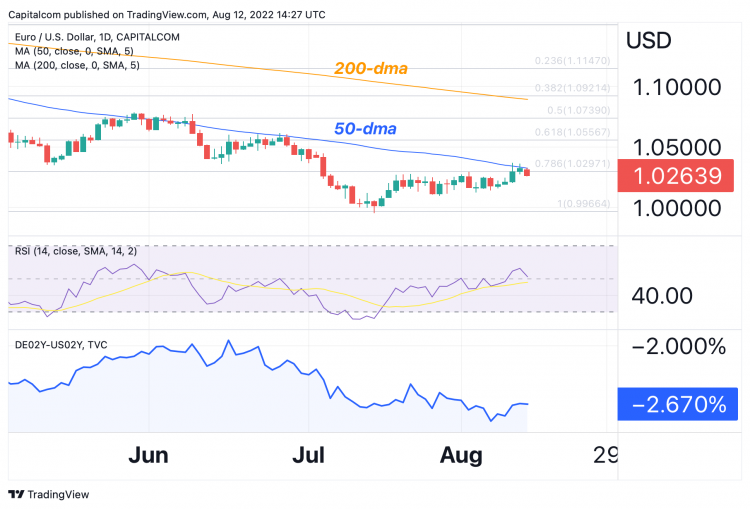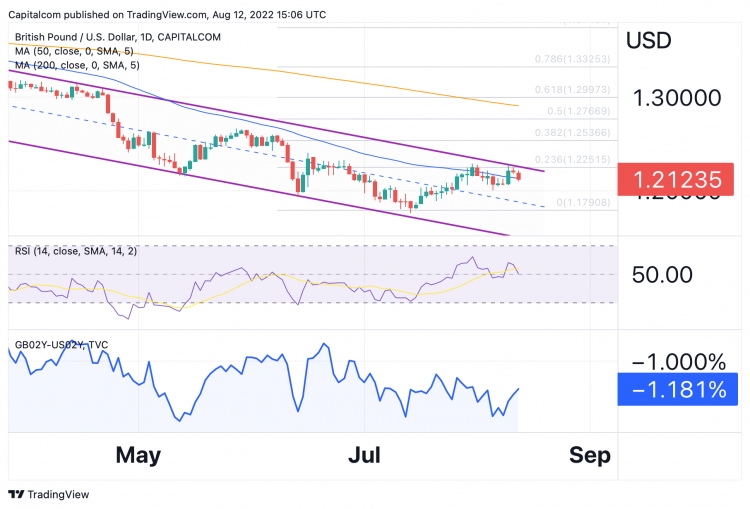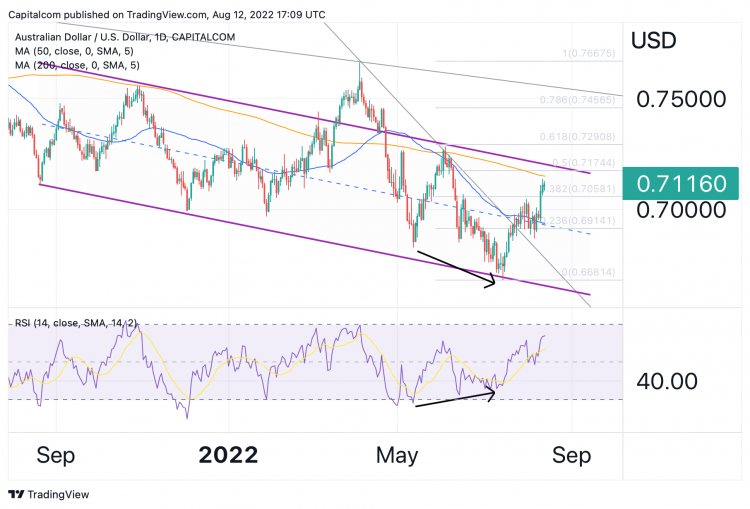
The bullish trend in the US dollar (DXY) that began in mid-2021 is facing some uncertainties in August 2022, as the US annual inflation rate in July fell more than expected (8.5% versus 8.7%), sparking speculation about a possible slowdown in the pace of Federal Reserve rate hikes in the coming months.
Meanwhile, the other major central banks, which started normalising interest rates later than the Fed, are still in the midst of a rate hike cycle, which could further erode the dollar’s rate advantage over its peers.
However, the United States appears to be better equipped to withstand an impending global economic slowdown due to its robust labour market, whereas other parts of the world, such as the Eurozone and the UK, are expected to suffer as a result of skyrocketing energy prices and shrinking real incomes. Therefore, widening growth disparities between the US and the rest of the world, as well as rising geopolitical risks in Ukraine or Taiwan, could still be supportive factors for the US dollar.
Let’s take a look at what’s going on the forex market by analysing charts to identify the most recent trends and trading signals in the five most important currency pairs.
Euro vs US dollar (EUR/USD) chart analysis: Parity fears haven’t gone away
 EUR/USD chart analysis as of August 12, 2022 – Photo: Capital.com / Source: Tradingview
EUR/USD chart analysis as of August 12, 2022 – Photo: Capital.com / Source: TradingviewThe euro (EUR/USD) is still stuck in a major downtrend against the dollar, which began in May 2021.
After reaching the parity level (1.00) in mid-July 2022, the single currency hinted at a rebound toward the dynamic resistance of the 50-day moving average, where it encountered a fierce selling pressure. Since the end of February 2022, the 50-dma has been a strong technical hurdle to overcome for the EUR/USD pair.
The yield differential between the German 2-year government bond and the US Treasury of the same maturity remains largely negative, indicating that monetary policy divergences between the Fed and the ECB still persist. The market believes that the ECB cannot go too far beyond the Fed in raising interest rates, amid fears of an impending recession in Europe due to the energy crisis and soaring inflation.
The daily RSI attempted to surpass 50 at the end of the first week of August, but was unable to exceed 60, indicating that buyer conviction is not particularly strong. Fibonacci retracement levels from the highs to the lows of 2022 show the first resistance at 1.03 (78.6%), followed by 1.0557 (61.8%).
However, the most recent price action in EUR/USD failed to decisively break through the 1.03-1.035 range. It could be a sign of a bear resurgence in the near term, which would likely push the pair back to test parity levels.
What is your sentiment on AUD/USD?
Vote to see Traders sentiment!
Pound sterling vs US dollar (GBP/USD) chart analysis: Bears still in control
 GBP/USD chart analysis as of August 12, 2022 – Photo: Capital.com / Source: Tradingview
GBP/USD chart analysis as of August 12, 2022 – Photo: Capital.com / Source: TradingviewSince June 2021, the pound (GBP/USD) has been in a bearish trend against the dollar, with declines intensifying in 2022.
GBP/USD hit a low of 1.175 in mid-July, the lowest value since March 2020, before attempting a recovery to 1.2285, where it collided with the descending channel’s trendline.
The cable’s brief recovery in the second half of July was due primarily to a broader weakening of the dollar rather than a strengthening of the pound.
The Bank of England (BoE) raised the Bank rate by half a percentage point to 1.75% at its August meeting, the highest rate hike in the UK in 27 years, in response to elevated inflationary pressures caused by Europe’s recent gas crisis. The BoE, however, forecasted inflation to peak at 13% in October this year and warned that the UK could enter a prolonged recession in the fourth quarter.
The gloomy economic pciture for the United Kingdom effectively acted as a brake on the British pound’s appreciation against the dollar.
The short-term rate differential between gilts and 2-year Treasuries has not increased significantly, indicating that the market is pricing in a longer rate hike cycle in the US than in the UK, owing to worsening macroeconomic conditions in the latter.
Technically, attempts to break the 50-day moving average did not result in upward price action extensions, providing false bullish signals. The bearish channel’s resistance at 1,228 held firm, triggering the return of sellers, with the RSI resuming its downward trend after a brief rise above 50.
The next support targets are 1.20 (psychological), 1.1891 (July lows), and 1.1760 (2022 lows). Bottom line, the dollar appears to have the upper hand against the pound at the moment, both fundamentally and technically.
US dollar vs Japanese yen (USD/JPY) chart analysis: Temporary relief, but not a game changer
 USD/JPY chart analysis as of August 12, 2022 – Photo: Capital.com / Source: Tradingview
USD/JPY chart analysis as of August 12, 2022 – Photo: Capital.com / Source: TradingviewThe dollar-yen (USD/JPY) pair has piqued the interest of traders in 2022, owing to the yen’s heavy depreciation, which lost 17% against the dollar in the first half of the year.
The remarkable USD/JPY rally reached a high of 139.4 in mid-July, the highest value since 1998, before losing momentum and beginning to fall. Fears of a global recession and the possibility that US inflation had reached its peak fueled the yen’s brief respite.
However, as long as the monetary policy gap between the Federal Reserve and the Bank of Japan persists, this cannot be considered a trend reversal in USD/JPY. The Fed has yet to signal a slowing in the pace of interest rate hikes, despite markets betting on this possibility, while the BoJ continues to maintain an ultra-accommodative monetary policy by keeping interest rates at zero.
The yield spread between the 2-year Treasury and Japan’s 2-year government bond remains wide and close to the June highs (3.5%), indicating that the market believes US interest rates will remain significantly higher than Japanese rates for the foreseeable future.
Technically, the 50-day moving average has been broken below USD/JPY, which then was unable to climb back above it. Dip buyers have been found on the price supports located at 130.4 and 131.8, preventing a further downside of the pair.
Consequently, in the absence of significant catalysts, such as a Fed dovish turn or a BoJ hawkish shift, both of which seem unlikely at this point, we could see a sideways market phase with USD/JPY between the support level of 131.7 and the resistance zone between 136.5 and 137.
US dollar vs Swiss franc (USD/CHF) chart analysis: Early signs of a new downward trend?
 USD/CHF chart analysis as of August 12, 2022 – Photo: Capital.com / Source: Tradingview
USD/CHF chart analysis as of August 12, 2022 – Photo: Capital.com / Source: TradingviewThe last few months of the dollar-Swiss franc exchange rate (USD/CHF) have been a roller coaster ride, with pullback and extension phases alternating one after the other.
The annual rate of inflation in Switzerland was 3.4% in July 2022, the same as in June, remaining at the highest level since October 1993 and well above the 2% target. At the same time, the unemployment rate is still at a record-low 2.2%, allowing for a sustained pace of interest rate increases.
The Swiss National Bank (SNB) unexpectedly raised interest rates by 50 basis points at its July meeting and is expected to do so again in September, bringing the policy rate into positive territory for the first time since July 2011.
The most prominent chart pattern on the USD/CHF daily timeframe was the double-top bearish reversal pattern, which formed in mid-June after the pair hit its second high at 1.006. Subsenquently, USD/CHF began its descent towards the neckline support zone at 0.95-0.955, which saw some buy-on-dip behavior emerging.
In the first half of July, there was a temporary recovery that struck with the resistance provided by the 23.6% Fibonacci retracement of 2022 highs to lows.
Since mid-July, however, the drop in USD/CHF has been more convincing. First, it broke through the 50-day moving average, and then it surpassed the 200-day moving average’s defence, which had been a very strong dynamic support over the year.
The pair also dropped below the 61.8% Fibonacci retracement level, which could mark the end of the bullish trend. A bearish channel has been formed, and the pair could first target to support at 0.93 (78.6% Fibonacci) before attempting to test the 2022 lows at 0.90.
The alternative scenario envisions a short-lived downward trend followed by a consolidation phase in the narrow range between 0.93 and 0.958 (50% Fibonacci).
Australian dollar vs US dollar (AUD/USD) chart analysis: Out of the woods?
 AUD/USD chart analysis as of August 12, 2022 – Photo: Capital.com / Source: Tradingview
AUD/USD chart analysis as of August 12, 2022 – Photo: Capital.com / Source: TradingviewThe Australian dollar-US dollar (AUD/USD) exchange rate travels within a bearish channel that has been in place since September 2021, despite the overshoot that occurred between March and April of 2022 that brought the pair to 0.765.
From then on, the Australian dollar plunged 13% against the greenback, reaching its year-to-date lows at 0.668 in mid-July. There, the RSI bullish divergence triggered the reversal of the short-term bearish trend, as AUD/USD reached fresh lows while the indicator rose.
Recently, AUD/USD has been able to overcome the 50-day moving average, albeit with some uncertainty, and project itself to the 200-day test, which represented a fierce resistance back in early June.
The Reserve Bank of Australia (RBA) backed the Aussie by raising the cash rate by 50 basis points for the second time in a row to 1.85% during its August 2022 meeting. The RBA has committed to further tightening, but not on a pre-set path, forecasting inflation to be slightly higher than 7% in 2022 and 4% in 2023.
The gloomier global growth outlook as a result of the war in…
Read More:EUR/USD, GBP/USD, USD/JPY, USD/CHF and AUD/USD – August 2022 update
2022-08-12 13:43:00
